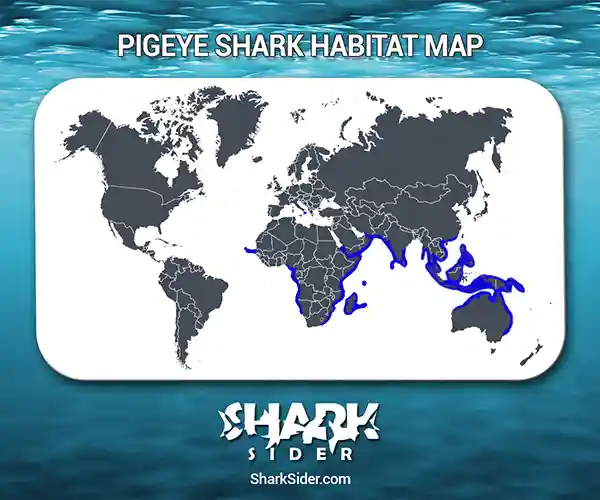The pigeye shark, or Java shark as it is sometimes referred to as, is a rare species of requiem shark. It is very similar in appearance to the bull shark, which has often led to confusion between the two.
Pigeye Shark Scientific Classification |
|
| Kingdom | Animalia |
| Phylum | Chordata |
| Class | Chondrichthyes |
| Order | Carcharhiniformes |
| Family | Carcharhinidae |
| Genus | Carcharhinus |
| Scientific Name | C. amboinensis |
Description
These sharks have very robust bodies, with a rounded snout and circular eyes. The largest fins the pigeye shark possesses are the first dorsal fin on its back and the pair of broad, falcate pectoral fins. There are dermal denticles all over the shark’s body, while inside its mouth, one can observe 11–13 upper and 10–12 lower tooth rows.
Pigeye sharks are grey dorsally and white ventrally, with a faint band distinguishing the two regions.
Where do they live
Map Of The Pigeye Shark’s Habitat

Due to this shark’s close resemblance to the bull shark, it has been hard to pinpoint the exact territories occupied by it. It lives in the coastal waters of Africa, Eurasia, and Oceania, with sightings in Australia, the Gulf of Aden, Indonesia, Madagascar, Nigeria, Pakistan, Papua New Guinea, Persian Gulf, South Africa, and Sri Lanka.
They live in coastal waters at a depth of 490 ft, preferring places with fine sediment and murky water.
Behavior
Hunting
As apex predators, these sharks hunt and feed on a wide variety of prey like angel sharks, cartilaginous fishes, catsharks, cephalopods, decapods, dolphins, eagle rays, gastropods, guitarfishes, requiem sharks, sea snakes, stingrays, and teleost fish like croakers, cutlassfishes, and flatfishes. They prefer hunting on the ocean floor and have even been observed feeding on whale carrion.
Social
Pigeye sharks are solitary, though sometimes several members of the same species have been spotted in the same territory.
Migratory
Juvenile sharks will spend most of their time in shallow waters, swimming into the intertidal zone with the rising tide and depart when the tide recedes.
As for adults, they are not particularly migratory, remaining over a range of 12 miles. The longest recorded distance traveled by a specimen so far is 670 miles.
Reproductive
They are viviparous, giving birth to 3-7 pups, each around 30 inches long. The gestation period varies depending on the location, lasting 9 months in northern Australia and 12 in South Africa.
Sexual maturity is seen in females when they are 7.2 ft long and 13 years of age, while males do so when they are 6.9 ft long and 12 years old. On average, males live for 26 years, and females live for 30 years.
Adaptations
This shark has nictitating membranes protecting its eyelids and a powerful caudal fin that lets them steer itself.
Interactions with humans
While its large size makes it potentially deadly to humans, it does not appear to be as aggressive as the bull shark, with no reports of the pigeye shark attacking humans.
Consuming the flesh of this shark is quite risky as it has been known to accumulate ciguatera toxins. The most infamous incident regarding this comes from Manakara, Madagascar, where in November 1993, over 500 people were poisoned after consuming the meat of a pigeye shark, with 98 fatalities.
Due to its rarity rendering the shark susceptible to overfishing, the IUCN labels the pigeye shark as “Vulnerable” or “VU”.
